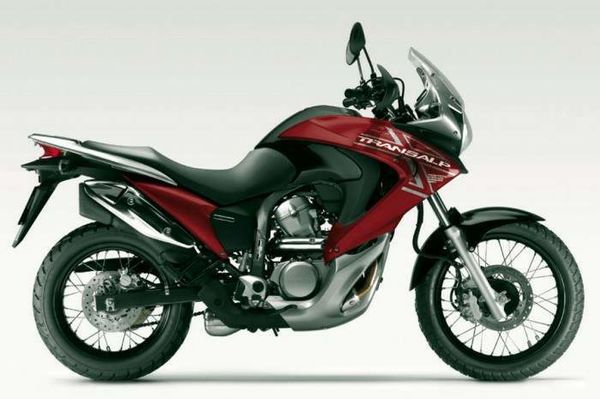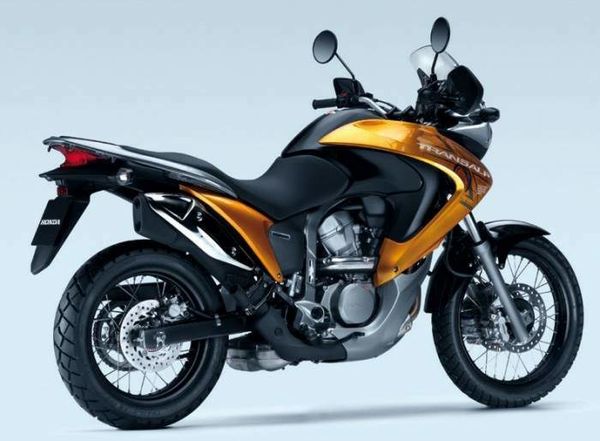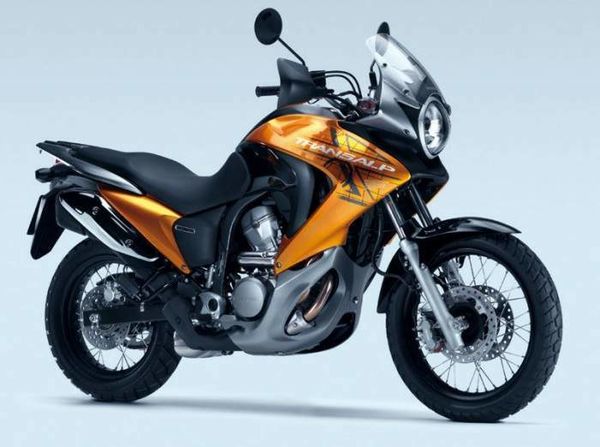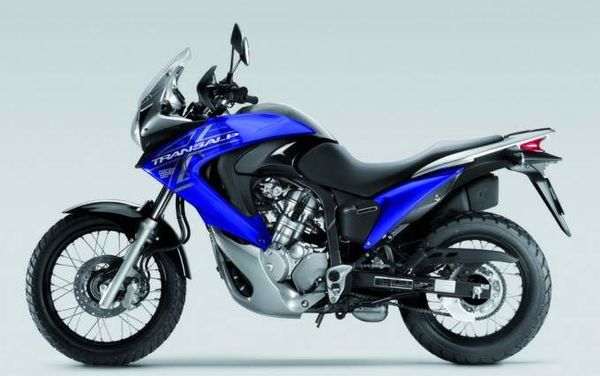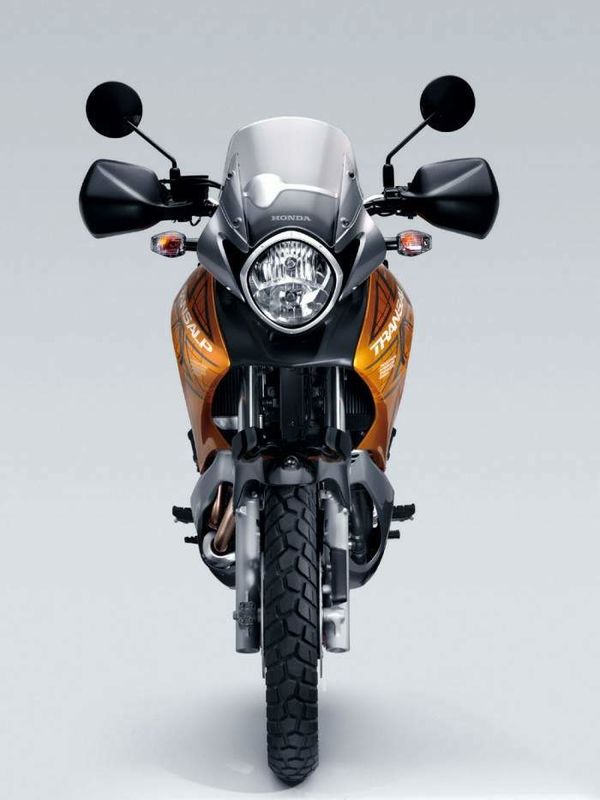Honda XL700V Transalp
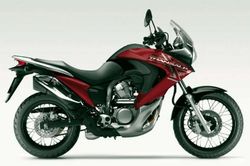 |
|
| Honda XL700 Transalp | |
| Manufacturer | |
|---|---|
| Also called | XL700V Transalp ABS, XL700V C-ABS, XL700V Transalp, XL 700 V Transalp |
| Production | 2008 |
| Class | Dual-purpose |
| Engine | Four stroke, 52o V-Twin, SOHC, 4 valves per cylinder |
| Compression ratio | 10.0:1 |
| Top Speed | 173.0 km/h |
| Ignition | Digital transistorized |
| Spark Plug | NGK, DPR8EA-9 |
| Transmission | 5 Speed |
| Frame | Aluminum, Trellis frame |
| Suspension | Front: 41 mm leading-axle fork Rear: Pro-Link with adjustable compression damping |
| Brakes | Front: 2x 256 mm discs 2 piston calipers Rear: Single 240 mm disc 1 piston caliper |
| Front Tire | 100/90 -19 |
| Rear Tire | 130/80 -17 |
| Wheelbase | 1,515 mm / 59.6 lbs |
| Seat Height | 841 mm / 33.1 in |
| Weight | |
| Oil Filter | K&N KN-204[1] |
| Recommended Oil | Honda GN4 10W-40 |
| Fuel Capacity | 17.5 Liters / 4.6 US gal |
| Manuals | Service Manual |
It could reach a top speed of 173.0 km/h.
Engine[edit | edit source]
The engine was a Liquid cooled cooled Four stroke, 52o V-Twin, SOHC, 4 valves per cylinder. The engine featured a 10.0:1 compression ratio.
Drive[edit | edit source]
Power was moderated via the Wet, multiple discs, cable operated.
Chassis[edit | edit source]
It came with a 100/90 -19 front tire and a 130/80 -17 rear tire. Stopping was achieved via 2x 256 mm discs 2 piston calipers in the front and a Single 240 mm disc 1 piston caliper in the rear. The front suspension was a 41 mm leading-axle fork while the rear was equipped with a Pro-Link with adjustable compression damping. The XL700V Transalp was fitted with a 17.5 Liters / 4.6 US gal fuel tank. The wheelbase was 1,515 mm / 59.6 lbs long.
Photos[edit | edit source]
Overview[edit | edit source]
Honda XL 700 V Transalp
The Transalp debuted on the European motorcycling scene in
1987 in response to the surging popularity of the Paris-Dakar Rally.
Combining elements of a mid-displacement tourer with a trail-going enduro
chassis and look, the Transalp pioneered a fresh new direction in motorcycle
development that has remained popular for over twenty years. Although
initially based on the intrepid rally bikes that raced across Africa, the
Transalp also won a strong and growing following for its superbly
comfortable ergonomics, confidenceinspiring control and inherent ability to
cruise high-speed motorways with strong, agile performance, and remarkable
riding ease.
Offering impressive appeal to a wide cross-section of riders who appreciate it uncanny ability to do most jobs remarkably well, from day-to-day commuting to longdistance touring, to exploring off the beaten path, the Transalp has always combined the best of on-road and off-road riding styles into a unique riding experience. However, eight years after its last major change in design, the Transalp has gradually fallen behind the times in terms of both style and performance, and was in need of both a new jolt of visual excitement and updates in its motorcycle technology to keep it at the front of its class in power, performance and environmental compatibility.
Setting out to firmly reassert the Transalps leading position in the mid-displacement Adventure Sports class, its development team drew up plans to give the next-generation Transalp a boldly dynamic new look, stronger power delivery and a more accessible range of riding enjoyment that would boost its appeal to even more riders attracted to its unique brand of versatile goanywhere performance. Offering cutting-edge style, strong, satisfying performance and an always inviting sense of adventure that makes every ride a great escape, the exciting new 2008 Transalp encourages one to seek out all the fun that lies just over the next horizon.
For its exciting next generation, the Transalps development team set out give it a more modern, adventurous design backed up by stronger, smoother performance that could indisputably re-establish it as the leader of the mid-displacement Adventure Sports class that it pioneered over 20 years before. Styling had to be distinctively aggressive and rider friendly, yet infused with an intrepid spirit that can carry its rider to the four corners of the Continent with confidence and ease, and bring them home again with the same exhilaration and comfort with which they set off on their riding adventures.
To achieve these goals, bold, totally new styling was designed and a totally new upgrade of its engine carried out in order to bring it up to date with the latest developments in engine performance. Its strong, highly reliable liquid-cooled V-twin engine remained central to the Transalps easy riding concept. This time-proven mill features slim proportions that contribute to the Transalps easier handling coupled with the dependable low-to-midrange grunt to carry two passengers and a full load of touring gear across the mountains that gave it its name. Fitted with a new fuel injection system and new 4-valve heads, this popular engine more smoothly, quickly and effortlessly powers over hills and revs up to highway speeds for highly enjoyable long-distance cruising that chases horizons with spirited ease.
The Transalps basic frame and chassis components, including its long-travel suspension systems, were retained with the idea of continuing to provide a comfortable upright riding position and a smooth, allround ride. For this new generation, the Transalps highspeed touring capabilities were further enhanced with a new smaller-diameter 19" front wheel and a wider new radial rear tire, which combine to more strongly emphasise its confidently responsive handling over Europes wide assortment of road surfaces.
Multi-purpose riding enjoyment has always been the central key to the Transalps appeal. With exciting new styling and swifter performance combining with the wider attractions of its easy-riding proportions and easily expanded carrying capability, the new 2008 XL700V Transalp sets the stage for greater riding enjoyment and broader horizons of more exciting touring adventures to come. The all-new XL700V Transalp really stands out with dynamic new Adventure Sports styling thats sure to turn heads wherever it goes. Its sleeker, more aggressively curved and angled bodywork speaks of breathtaking road-going agility and a lighter, fresher way of enjoying all the thrills that motorcycling has to offer. Modelled on the image of galloping horse, the Transalps intrepid new lines seem to strain at the reins even when standing still.
The Transalps compact new front cowl area features an aggressive wind management design that intentionally does not provide the same degree of wind protection offered by its predecessor. Instead, this crisply attractive new design reduces the amount of wind blast to the chest while providing a more enhanced wind feel that deftly avoids becoming uncomfortable. Wind-tunneltested ports under the mini windscreen and to the sides of the headlight expand air flow around the rider for enhanced wind protection at higher speeds and lighter, more responsive handling. Behind the screen resides a compact, cleanly integrated instrument panel with large tachometer dial and large LCD readout of speed, odometer, dual trip, clock and six-segment fuel level.
The new Transalps fuel tank is smaller in capacity than its previous version (down from 19 to 17.5 liters ), but the greatly improved fuel consumption figures of its new fuel-injected engine actually extend its riding range. A flat, flush-mount hinged fuel tank cap eases fill-ups while contributing to the bodyworks more modern look. Twin-Bulb Multi-Reflector Headlight Accentuating the front cowls distinctive new form is an integrated twin-bulb multi-reflector headlight that features separate bulbs for low and high beams to offer excellent night-time riding visibility. This design also greatly extends bulb life by using separate single-filament bulbs that reduce heat build-up within the housing.
GPS-Inspired Graphics The bold graphics surrounding the Transalp name on the shoulders of its aggressively sculpted side cowls were inspired by the modern, high-tech design of a GPS readout, accentuating the Transalps far-ranging appeal. The position numbers correspond to the peak altitude of the highest paved road accessible by motorcycle in Europe: at Col de la Bonette, located in the southern French Alps.
The Transalps slim, comfortably contoured tandem seat offers excellent long-distance riding comfort combined with a relatively low seat height that provides an easy reach to the ground for most riders. Surrounding the back of the seat is a sleekly styled new moulded resin rear carrier that brackets the attractively curved integrated taillight while providing comfortable hand grips for pillion passengers. Curvaceous design also extends to the Transalps new moulded resin undercowl, which more attractively integrates with the bold new lines of its bodywork to provide excellent protection for the lower engine and its components. The new 2008 XL700V Transalp will take to the road in four distinctive color variations which each provide a strong visually contrasting complement to its black fuel tank, seat, wheel rims and mudguards. This quartet of attractive style leads off with a shimmering golden metallic yellow that grabs attention with its brilliant hue. Next, a deep, luxurious metallic red provides a glamorous accent on the Transalps attractive new curves. This is followed by a subtle metallic grey that blends in with the greys of its front cowl, engine, undercowl and rear carrier to extend a modern monochromatic sheen that is accentuated by the black of its other body parts. Finally, a rich metallic blue completes the scene with a sophisticated image of urban refinement. The Transalps compact, smooth and powerful liquidcooled three valve-per-cylinder V-twin engine has won an enthusiastic following for delivering strong, versatile performance over every road it travels. Debuting out in 1987 with a displacement of 583cm3, this incredibly dependable, hard-working mid-displacement powerplant has received few major modifications over its long lifetime of service, save for an increase to 647cm3 in 2000 that boosted its low-to-midrange torque for enhanced touring and passing performance.
Now, with a dynamic new third generation of the Transalp in development, the time has come to bring its engine up to date with further improvements to its overall performance and environmental compatibility. To achieve these aims, the Transalps development team turned to the latest generation of this venerable middisplacement V-twin engine, which was recently developed for 2006 Deauville. Featuring larger displacement, new PGM-FI fuel injection and freer flowing four-valve heads, this new engine incorporates a host of upgraded and redesigned components to improve performance, environmental compatibility and riding ease. Larger Displacement The Transalps new engine features a 2mm larger cylinder bore (up from 79 to 81mm), which increases total capacity by 33cm3, from 647 to 680cm3. These larger pistons and their connecting rods are also lighter, contributing to the engines sharper throttle response and more forceful acceleration. While this new engines larger displacement is responsible for some of the Transalps stronger power and torque, it is only one of several factors in the new engines total performance equation. New 4-Valve Heads The Transalps new engine also sports 4-valve heads and new porting that permits smoother, more efficient flow of intake and exhaust gasses through the combustion chambers, as well as more complete filling of the combustion chambers on the intake stroke: better breathing for better performance. With new centrally located spark plugs ensuring a quicker and more efficient spread of the combustion flame across the tops of the pistons, the heads more compact combustion chambers also achieve a higher compression ratio (up from 9.2 to 10.0 : 1) for stronger thrusts of power and smoother overall performance characteristics. New PGM-FI Fuel Injection System Like all of Hondas road bikes for 2008, the new Transalp also features Hondas advanced PGM-FI electronic fuel injection system for accurate fuel delivery, quick, easy starts, highly responsive throttle control and exceptionally low exhaust emissions. The system uses two 40mm throttle bodies integrated into one crossed unit, and high-performance 12-hole injectors for optimized atomisation that results in stronger power, more responsive throttle control and smoother, flatter power output from low to high revs, along with a more linear and forceful feel of torque-filled performance. Not only does this system contribute to the new Transalps stronger power output, it is also responsible for providing a 7% increase in fuel economy and lower emissions compared to its previous smaller-displacement engine configuration. Lower Emissions As with nearly all of Hondas latest fuel-injected engines, the Transalps new engine reduces its exhaust emissions to well below EURO-3 regulated levels by means of an integrated HECS3 oxygen-sensing catalytic converter system. The exhaust system also features a large-capacity 300-cell catalyser element, which is located just under the swingarm pivot. The complete system effectively minimises the emissions of carbon dioxide (CO), hydrocarbons (HC) and nitrous oxides (NOX) while maintaining strong and smooth performance throughout the engines impressive powerband, and ensuring full EURO-3 compliance.
Stronger Performance With its new engine, the Transalp produces significantly stronger performance, especially in its wide midrange, for a more impressive surge of roll-on acceleration whenever the throttle is opened wide, even when carrying a passenger and load of gear. Fitted with a liquid-cooled oil cooler, the engine is also rugged and reliable, and always ready to set out on long tours whenever and wherever the urges takes one.
Finally, if anything stands out in the V-twin riding experience, it is the exhilarating sound that the engine produces as it rolls up to speed. With its shorter, more cleanly integrated exhaust system, the new Transalp gives non-stop satisfaction with a pleasing rumble of Vtwin sound, especially in the lower registers. Just one more invigorating attraction for the Transalps unique realisation of complete Adventure Sports riding enjoyment and long-distance touring pleasure. The new 2008 Transalp is built on essentially the same rugged double-cradle steel tube frame it has used since its second generation debuted in 2000. Its composite box-section construction incorporates the engine as a stressed member for an outstanding balance of light weight, strength and rigidity that optimises riding performance for smooth, effortless handling. Its 10mm longer wheelbase makes a small but significant contribution to the Transalps enhanced high-speed manoeuvrability, especially noticeable when carrying a pillion passenger and extra luggage.
The Transalps popular long-travel suspension system includes the same 41mm leading-axle telescopic front fork used till now, although without the earlier versions front fork gaiters, while its progressive and smoothly compliant Pro-Link rear suspension assures a comfortable, confidently controlled ride over a wide range of road surfaces, whether riding solo or fully loaded for several days touring. New Smaller 19" Front Wheel The new Transalp now rolls on a lightweight 19" wirespoked, aluminum-rimmed front wheel with a wider profile 100/90 tire than the 21" wheel it replaces. This smaller wheel diameter provides easier in-town riding control and smoother handling at highway speeds. A wider new 130/80 radial rear tire replaces the bias ply tire mounted on the Transalps previous edition for more reassuring riding ease, especially in fast corners. Standard and Combined-ABS Triple-Disc Brakes In its standard version, the new Transalp offers the responsive braking control of a lightweight pair of dual-piston front callipers gripping lightweight 256mm drilled rotors between sintered metal pads. At the rear, its box-section swingarm mounts a compact singlepiston caliper stopping a 240mm rotor in a conventional setup that provides strong braking response to match the new Transalps sporty looks and riding capability.
High-Performance Combined-ABS Version The new Transalp is also available in an advanced Combined-ABS configuration that features the reassuring braking control of Hondas proven Combined Brake System coupled with the smooth, confidence-inspiring operation of its popular Antilock Brake System. Visually, the only major difference between the standard and Combined-ABS versions of the Transalp are its callipers. In place of the standard versions dual-piston callipers, the Combined-ABS version mounts a set of three-piston callipers. The right-side of each wheel also mounts a small pulsar ring, which is constantly monitored by the Antilock Brake System.
The ABS portion of the Transalps highly effective Combined Antilock Brake system operates in precisely the same way as Hondas other ABS-equipped models. When braking over uneven or slippery road surfaces, this high-accuracy system instantly reacts to the most minute variations in the relative speed of the two wheels, predicting and counteracting tire slip before it happens. With precise control, the system maintains just enough brake pressure for smooth and steady deceleration in slippery conditions that greatly enhances confidence in ones ability to stop quickly and surely.
This Combined-ABS versions Combined Brake System links the rear brake pedal to the centre piston of its rightside three-piston front brake caliper to provide a measured balance of front brake control whenever the rear brake is firmly used. An inline delay valve ensures that light operation of the rear brake, such as when trailing through a corner, has little or no effect on front brake operation.
Stronger pressure applied to the rear brake pedal results in just enough front brake engagement to provides a positive balance of front and rear braking forces for smoothly controlled operation. The remaining five pistons of the two three-piston front brake callipers are controlled by the hand brake lever and operate in a conventional manner, providing reassuringly strong braking control to match the Transalps sporty riding capability.
Confident riding control also requires strongly assured braking performance, and the Transalps advanced Combined-ABS version provides an exceptional level of smoothly responsive braking control to give both seasoned experts and less experienced riders more confident stopping power in situations where optimal braking capability is crucial.
| Make Model | Honda XL 700V Transalp |
|---|---|
| Year | 2008 |
| Engine Type | Four stroke, 52o V-Twin, SOHC, 4 valves per cylinder |
| Displacement | 680.2 cc / 41.5 cu-in |
| Bore X Stroke | 81 x 66 mm |
| Cooling System | Liquid cooled |
| Compression | 10.0:1 |
| Lubrication | Wet sump |
| Induction | Electronic fuel injection 40mm throttle bodies |
| Ignition | Digital transistorized |
| Spark Plug | NGK, DPR8EA-9 |
| Starting | Electric |
| Max Power | 59.1 hp / 44 kW @ 7750 rpm |
| Max Torque | 60 Nm / 44.3 ft.lbs @ 5500 rpm |
| Clutch | Wet, multiple discs, cable operated |
| Transmission | 5 Speed |
| Final Drive | Chain |
| Frame | Aluminum, Trellis frame |
| Front Suspension | 41 mm leading-axle fork |
| Front Wheel Travel | 177 mm / 7.9 in |
| Rear Suspension | Pro-Link with adjustable compression damping |
| Rear Wheel Travel | 173 mm / 6.8 in |
| Front Brakes | 2x 256 mm discs 2 piston calipers |
| Rear Brakes | Single 240 mm disc 1 piston caliper |
| Front Tire | 100/90 -19 |
| Rear Tire | 130/80 -17 |
| Dimensions | Length 2250 mm / 88.6 in Height 1305 mm / 51.3 in Width 905 mm / 35.6 in |
| Wheelbase | 1,515 mm / 59.6 lbs |
| Seat Height | 841 mm / 33.1 in |
| Ground Clearance | 177 mm / 7.0 in |
| Dry-weight | 214 kg / 472 lbs |
| Fuel Capacity | 17.5 Liters / 4.6 US gal |
| Consumption Average | 19.2 km/lit |
| Standing ¼ Mile | 13.5 sec |
| Top Speed | 173.0 km/h |
Videos[edit | edit source]
References[edit | edit source]
- ↑ 2019 K&L Supply Co Catalog. K&L Supply Co. 2019.
